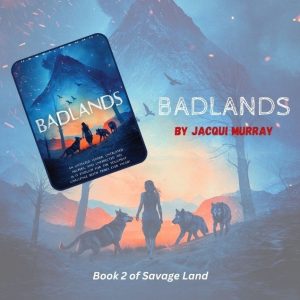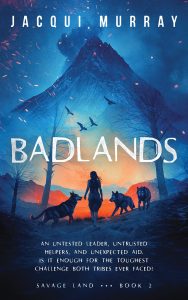Note from Liesbet: Ever since I discovered Jacqui’s blog, WordDreams, I’ve been fascinated by her prehistorical fiction writing and characters and I’ve been impressed by the amount of research, passion, and skill that goes into creating her three trilogies that make up her Man Vs. Nature saga. Here is my review for Born in a Treacherous Time, the first book in her first trilogy, Dawn of Humanity.
Previously, I gave her a shout-out on Roaming About in 2021, when Laws of Nature, book 2 in Dawn of Humanity came out and she provided a guest article in 2022 about the wanderlust of prehistoric nomads, to promote Natural Selection, the third book in that series.

Badlands
Jacqui launched her third trilogy in the Man Vs. Nature saga this year. It’s called Savage Land and the second book in this set, Badlands, was just released. Jacqui has been as interested in our lifestyle as I’ve been in that of her characters. As “modern-day nomads”, Mark, Maya, and I don’t have a lot in common with our roaming ancestors, but we are almost as curious about what’s behind the horizon! 🙂
Over to you, Jacqui. If anyone has questions for my author and blogger friend, please ask them in the comment section. She will check in to elaborate and interact.

Thank you for inviting me to your blog today, Liesbet, to talk about the lifestyle of the Neanderthal characters in my newest book, Badlands. Neanderthals lived in a vast swath of Eurasia, from the Atlantic shore to the Altai Mountains in Siberia. They migrated often in response to the movement of herds, the fruiting of trees, and the weather. Evidence left behind in their home-of-choice, caves, shows they stayed there for only a few weeks to a month before moving on.
Why were Neanderthals nomadic?
The reasons for the Neanderthal nomadic lifestyle is similar to those of today’s nomads:
- They were hunter-gatherers. Herds moved so the Neanderthals moved. Edible plants expired or grew–tribes followed them. Their lifestyle was to use different resources in different places.
- They lived in small groups. They moved around to find more of their kind, to mate with and pairmate–to continue the species.
- Each group shared their skills with other Neanderthal tribes.
- They didn’t own materials–clothing, weapons, tools, pottery, jewelry, artwork. They believed materials were shared by all. They took with them what they could carry in their hands (spears and club-like cudgels) and (I speculate) in a shoulder sack (stone tools, extra pelts, travel food, an ember to start a fire). Since they owned nothing and what they had could be reproduced, there were no reasons to establish a home to keep their belongings as we-all do.
Today’s nomads
The modern-day Hadza (also known as the Hadzabe) are historically nomadic, moving with the seasons. They have been doing this for the last 50,000 years. Neanderthals disappeared 45,000 years ago, though they didn’t make it as far south as Africa. They never would have known the Hadza, but their lifestyles overlap with a lot of similarities despite the massive difference in time.
If you’re interested in the lifestyle of modern hunter-gatherers who are as old as the Neanderthals in my story, check out this 43-minute (slow and raw) documentary, viewed by over 2.4 million:
Here is some more information about Jacqui Murray and her new trilogy, Savage Land:
Summary
Savage Land is the third prehistoric man trilogy in the series, Man Vs. Nature. Written in the spirit of Jean Auel, Savage Land explores how two bands of humans survived one of the worst natural disasters in Earth’s history, when volcanic eruptions darkened the sky, massive tsunamis crossed the ocean in crushing waves, and raging fires burned the land. Each tribe starring in the story considered themselves apex predators. Neither was. That crown belonged to Nature and she was intent on washing the blight of man from her face.
In Endangered Species, Book One of the trilogy, Yu’ung’s Neanderthal tribe must join with Fierce’s Tall Ones—a Homo sapiens tribe–on a cross-continent journey that starts in the Siberian Mountains. The goal: a new homeland far from the devastation caused by the worst volcanic eruption ever experienced by Man. How they collaborate despite their instinctive distrust could end the journey before it starts or forge new relationships that will serve both well in the future.

Cover Badlands
In Badlands, Book Two, the tribes must split up, each independently crossing what Nature has turned into a wasteland. They struggle against starvation, thirst, and desperate enemies more feral than human. If they quit or worse, lose, they will never reunite with their groups or escape the most deadly natural disaster ever faced by our kind.
Join me in this three-book fictional exploration of Neanderthals. Be ready for a world nothing like what you thought it would be, filled with clever minds, brilliant acts, and innovative solutions to potentially life-ending problems, all based on real events. At the end of this trilogy, you’ll be proud to call Neanderthals family.
Book information Badlands:
Print, digital, audio available: http://a-fwd.com/asin=B0DFCV5YFT
Genre: Prehistoric fiction
Editor: Anneli Purchase

Author bio:
Jacqui Murray is the author of the popular prehistoric fiction saga, Man vs. Nature which explores seminal events in man’s evolution one trilogy at a time. She is also author of the Rowe-Delamagente thrillers and Building a Midshipman , the story of her daughter’s journey from high school to United States Naval Academy. Her non-fiction includes 100+ books on tech into education, reviews as an Amazon Vine Voice and a freelance journalist on tech ed topics.
Excerpt of Badlands
Continue reading





